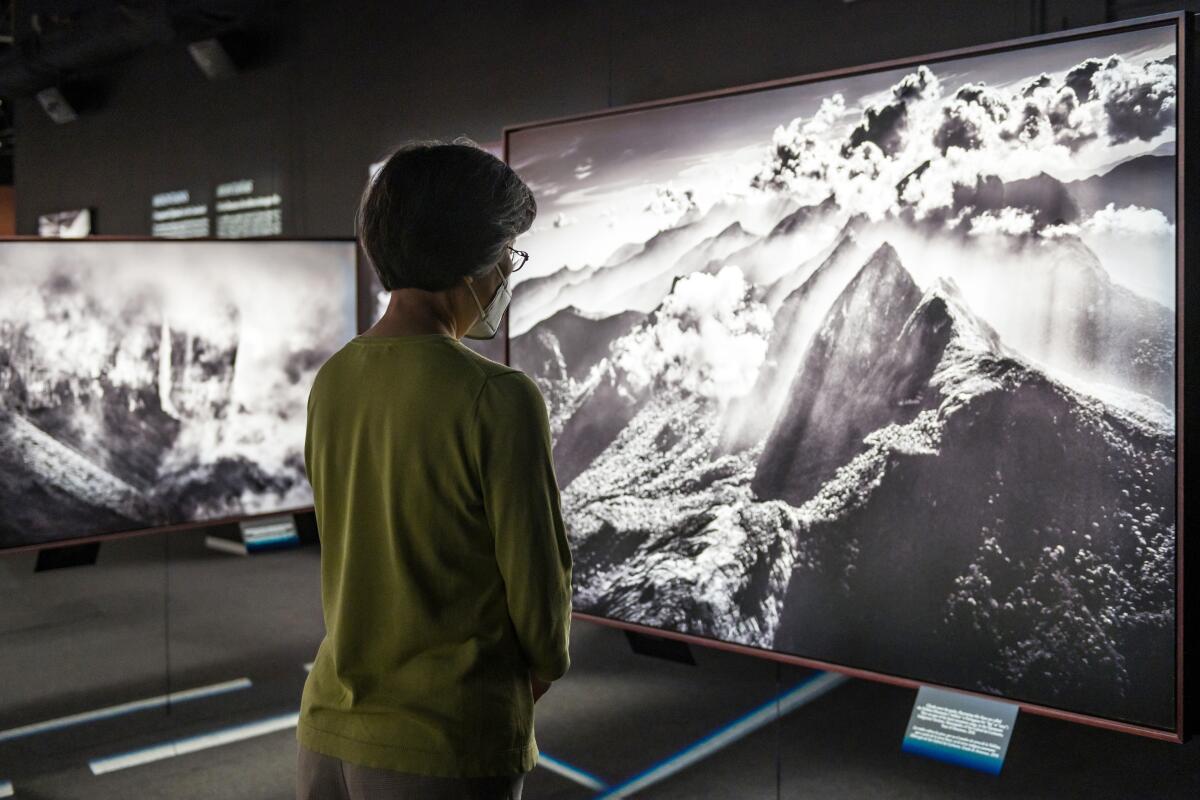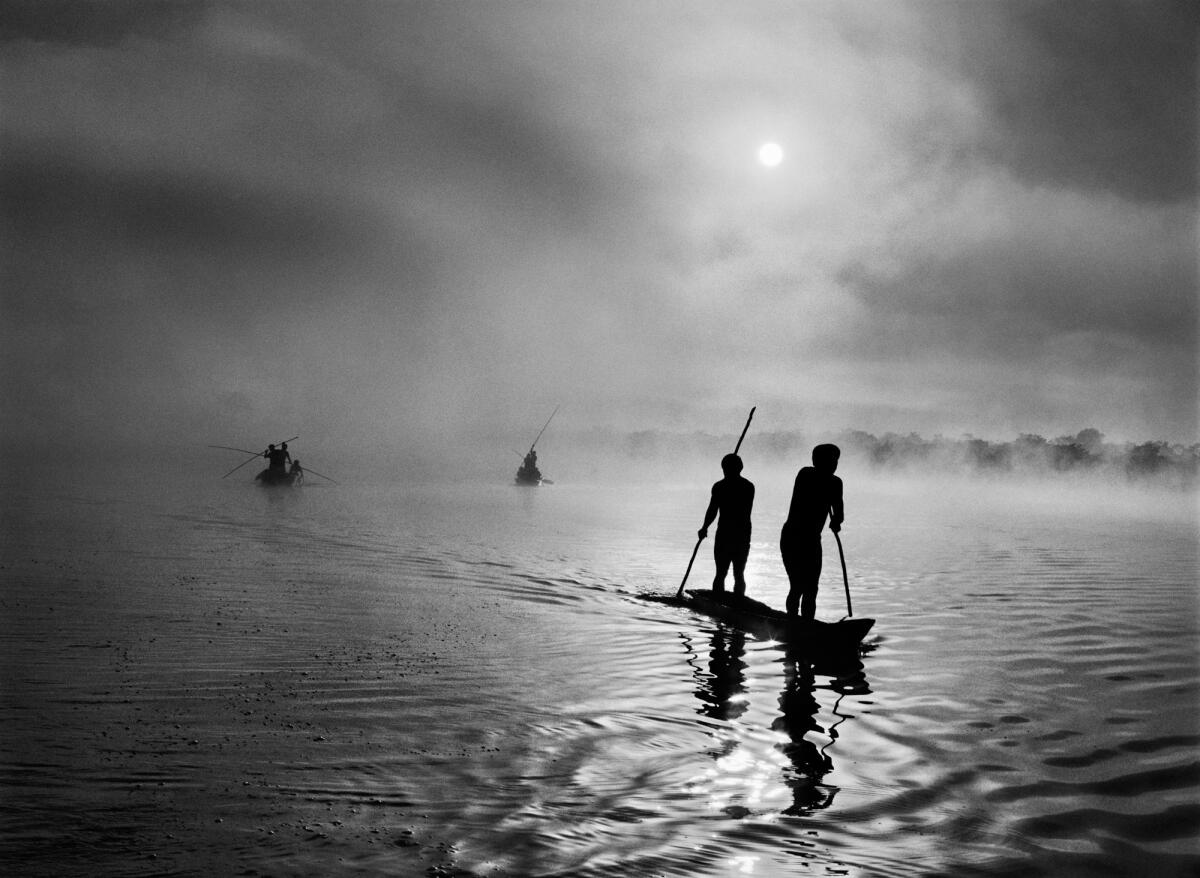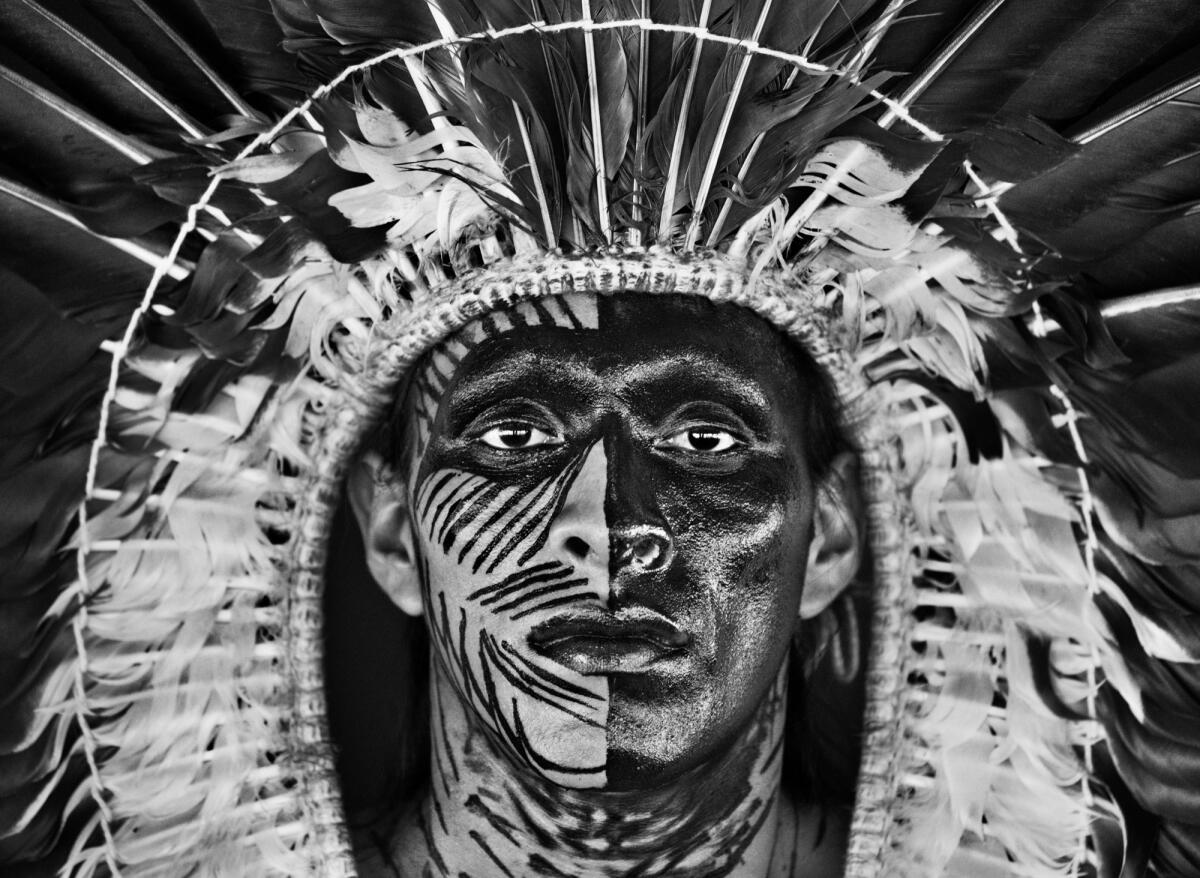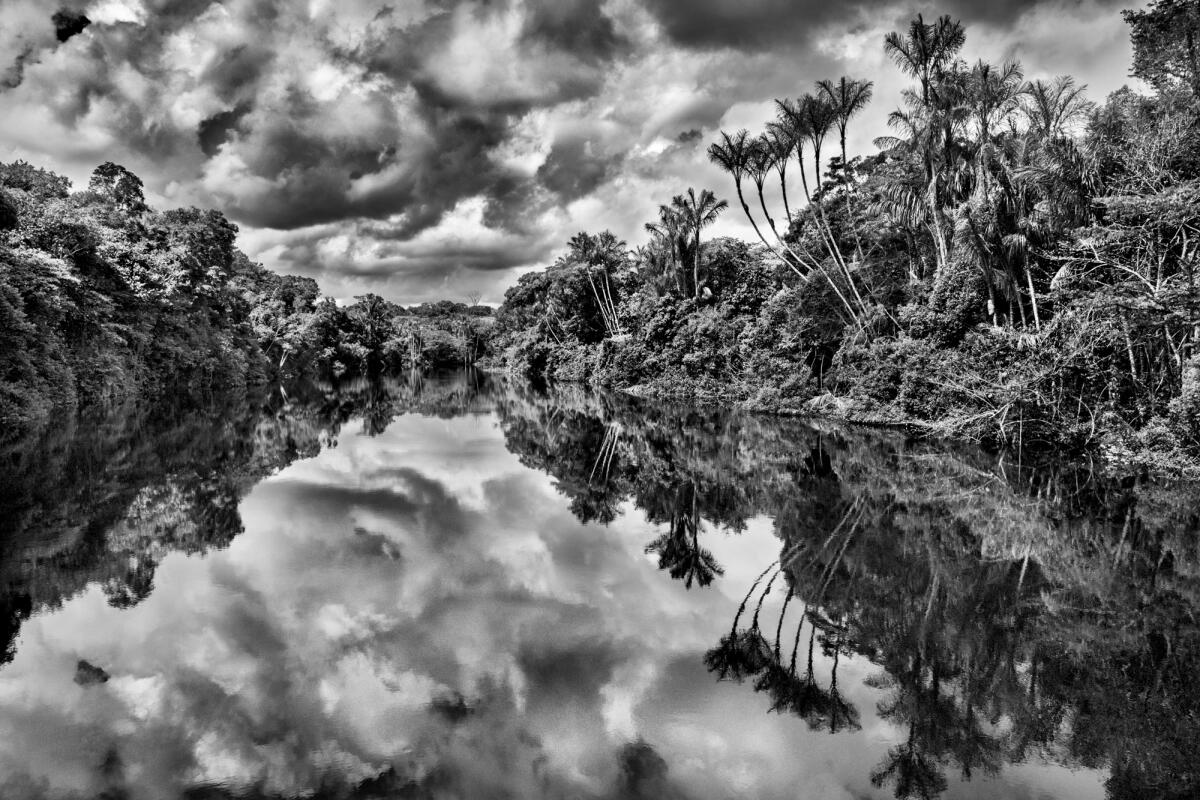Are Californians destroying the Amazon? A Sebastião Salgado exhibit raises hard questions

- Share via
If this week you happen to find yourself grimacing as you cruise past the oil refineries and drilling platforms that pockmark Los Angeles’ coastline, you may want to make a sharp eastward turn to the California Science Center, next to the Coliseum.
Once there, if you wander into an immersive third-floor gallery, you’ll be visually and aurally transported to the Amazon rainforest, conjured up through 200 photos by Brazilian documentary photographer and photojournalist Sebastião Salgado and a Jean-Michel Jarre soundtrack.
But you also may be jolted back to Southern California with a most inconvenient truth about our cherished West Coast lifestyle.
Threading your way around the installations, which mimic a passage deep into the jungle toward hidden human settlements, Salgado’s backlit, black-and-white images of sculptural rubber trees, massive freshwater archipelagos and cloud-shrouded mountains envelop you. Painted and pierced faces regard you with friendly curiosity and perhaps a touch of wariness. Jarre’s sinuous soundscape of exotic bird cries, torrential rainfall and Indigenous musical instruments floods the room.
“Amazônia — Photography by Sebastião Salgado” is making its only U.S. appearance at the California Science Center following previous engagements in London, Rome and Paris. The free exhibit closes here Monday before heading on to Milan, Zurich, Madrid and Brussels.
Characteristically, Salgado’s photos can be appreciated purely for their technical virtuosity and aesthetic pleasure. But they also serve as testimonials to what is already lost and what further losses may come, as illegal miners, oil drillers, lumber harvesters and cattle ranchers pour into the Amazonian region, which is largely spread across Brazil (60%), with lesser shares in Peru (13%), Colombia (10%), Bolivia, Ecuador and other countries. At least 20% of the Amazon territory has been burned away, chopped down or submerged by dams.
Jeff Rudolph, the center’s chief executive officer, says the exhibit is a clear extension of Salgado’s previous work illustrating the complex interface between humans and the natural world.
“It’s about people, Indigenous people, which he cares deeply about,” Rudolph said. “What I love about them is that they’re timeless. You could look at those images and it could’ve been last year or it could’ve been 100 or 200 years ago.”
Rudolph says the exhibit wouldn’t have made it to L.A. if not for philanthropist Wallis Annenberg, who read about the show when it was in London and paid to bring it here. In an email, Annenberg wrote that she regards Salgado as “one of the greatest storytellers ever to hold a camera.”

“Conservation has always been at the heart of my philanthropy, and a big part of the challenge is raising awareness, getting people to understand the threat on a visceral level. That’s where Salgado’s gifts come in,” Annenberg wrote in her email.
“The rain forests — as well as the Indigenous people within them — are increasingly under assault,” she continued. “Salgado doesn’t just make us understand this, he makes us feel it. It’s powerful and searing and sobering work.”
Both sensations were at play at the California Science Center last week at a special viewing of the show. As guests entered and exited they were invited to browse a table laden with reports titled “Blood Gold” and “Linked Fates: How California’s Oil Imports Affect the Future of the Amazon Rainforest.” The literature, published by environmental groups like Amazon Watch, STAND.earth and Articulação dos Povos Indígenas do Brasil, delineates the consequences of California’s historic dependence on its oil economy, as well as the ecological toll of mining the Amazon to harvest the minerals that power our smartphones and other consumer hardware.
“Californians are unknowingly complicit in the destruction of the Amazon through our gas pumps,” said Leila Salazar-López, an activist with Amazon Watch who attended the viewing. Amazon Watch is calling on Gov. Gavin Newsom to end the state’s importation of crude oil shipments from the Amazon to California refineries.
“If we want to protect our climate, if we want to stop the drought, stop the further climate chaos that we’re in, whether it’s fires or floods or droughts, we need to end our addiction to Amazon crude,” Salazar-López added.

Seven years in the making, Salgado’s Amazônia photos were purposefully conceived in black and white, said Diane Perlov, the center’s senior vice president for exhibits.
“If you see color you’re going to overlook a lot of the details of the content,” she explained. “He wanted people to focus on what’s in the picture.”
Several images show the uncanny way in which the natural flow of the river sculpts the Amazon’s islands into biomorphic shapes resembling Earth Art. Other photos illustrate how the moisture expelled by the dense rainforest is recycled into floating rivers that scientists believe can affect weather systems in the faraway Northern Hemisphere. The steady withering of the rainforest could help diminish the annual snowpack in the Sierra Nevada, which melts to fill the swimming pools and irrigate the golf courses of Southern California.
Salgado’s portraits and candids of Amazon natives — nearly all of whom are fully named in the didactics — are as specific and intimate as his nature shots are majestic and cosmic.
“They break a lot of stereotypes about what people think of Indigenous people,” Perlov said. “They’re very knowledgeable about what’s happening in their world and very connected.”
Wrote Annenberg in her email: “The work is never exploitative, not even close. There’s a real connection, a deep empathy for his subjects.”

With the return to office on Jan. 1 of former President Luiz Inácio Lula da Silva, hopes have surged in Brazil and abroad that the remainder of the Amazon still can be preserved relatively unscathed, and that some of its ravaged sections may even be restored. But although Lula has vowed to reverse his predecessor Jair Bolsonaro’s anti-environmental agenda, his main priority is creating jobs to jump-start Brazil’s sputtering economy.
The first 100 days of Lula’s administration “are going to be critical,” said Salazar-López. “What we are hoping for is that there be a joint collaboration between Lula and [President] Biden and our governments to fully protect the Amazon. It’s not just enforcing the law that exists. It’s expanding it.”

More to Read
Sign up for Essential California
The most important California stories and recommendations in your inbox every morning.
You may occasionally receive promotional content from the Los Angeles Times.











